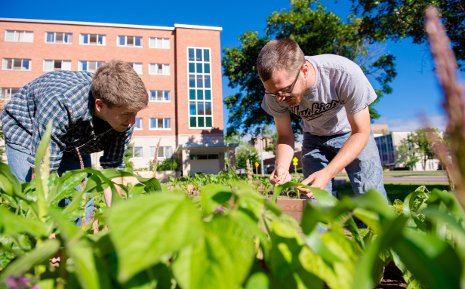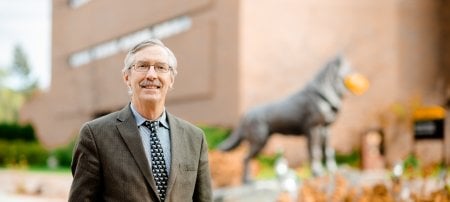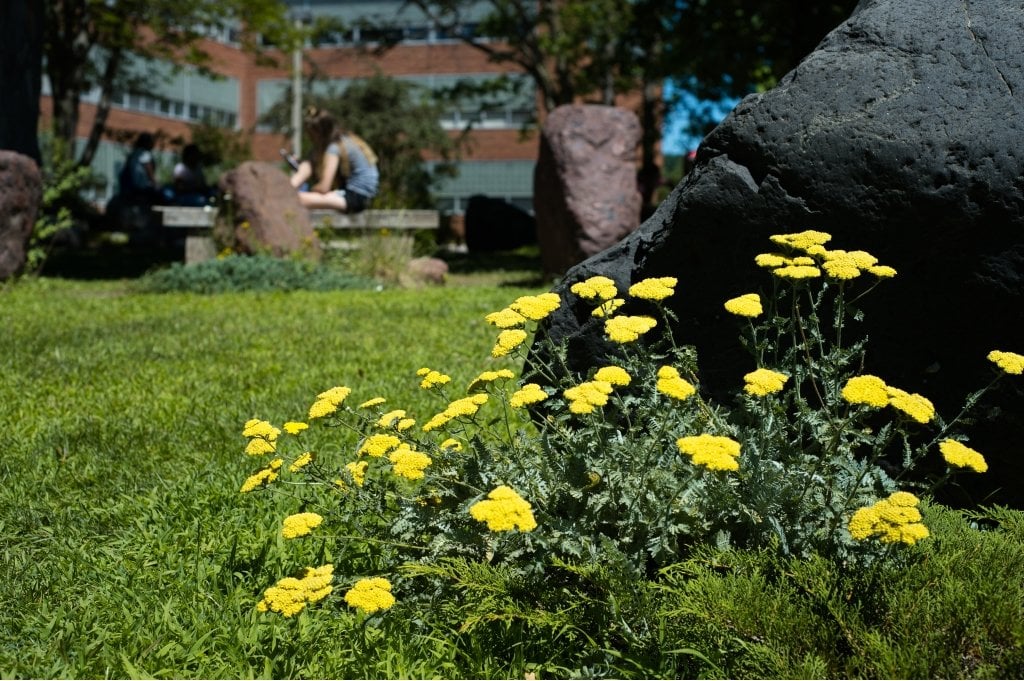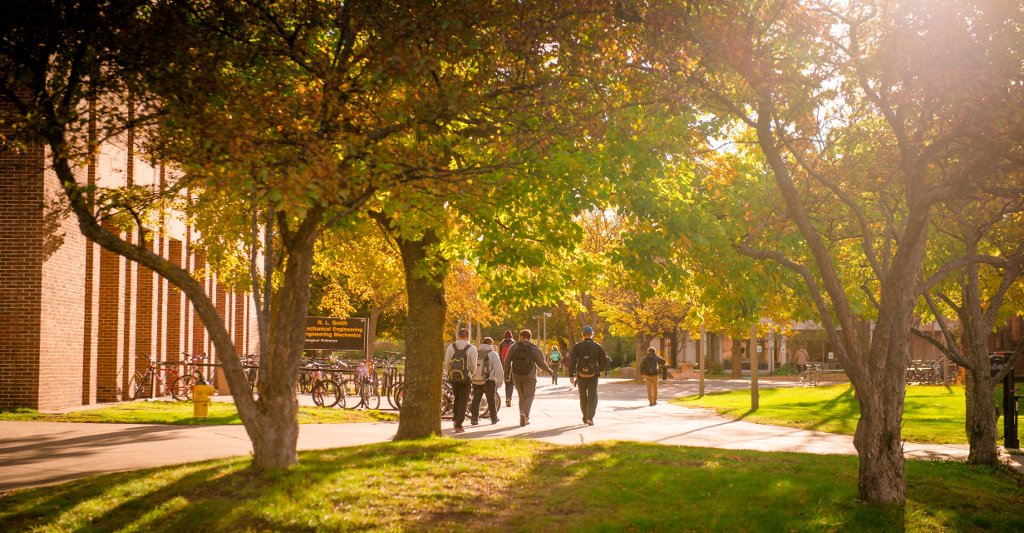Sustainable Vegetable Garden Takes Root at Tech

This spring, a small vegetable garden cropped up in the Wadsworth Hall courtyard.
There’s more to this garden than organic produce for students in Wadsworth Hall; the project partners hope that sustainably growing produce on campus will also raise food awareness. The garden is an interdepartmental collaboration of Housing and Residential Life, the Sustainable Futures Institute, Facilities Management, Dining Services and Student Affairs.
The garden contains more than 22 types of vegetables and herbs, including basil, bok choy, cauliflower, flint corn, okra, parsley, pumpkin, radishes, spinach, wax beans and seven tomato varieties. The plants live in 22 raised beds handcrafted of cedar planks, which allow for adequate soil drainage; the boxes measure eight feet long by four feet wide and are two heights: 11 or 33 inches.
Everything harvested will be incorporated into meals served in the dining hall. And all the backbreaking work of tending a garden is beginning to pay off—the first few batches of radishes went on the salad bar. Planting and harvesting is successional and will continue well into the fall semester.
“Providing produce to Dining Services is a way of reaching out to the most students with the least amount of space,” says Alex Bruns, a residential life coordinator and gardener. “This is never going to put a dent in the dining hall’s produce needs. But we are growing lots of herbs and tomatoes because you can extend them quite a bit in sauces, in the salad bar or as a base for dishes.”
Tony Hayes, who is the lead gardener and a Peace Corps Master’s International student, says raising food awareness is an important aspect of the garden. “Because of the advents and dominance of industrial agriculture today, there’s that divorce between food and person,” he says. “Yesterday I was pulling radishes, and worms had eaten half of them, and some of them were woody. Not everything is pristine, like when it comes packaged in the store. There’s a lot of loss that goes along with a garden.”
The Wadsworth garden is sustainable through and through. But what, exactly, constitutes sustainable gardening? The gardeners employ green pest management, or “squishing every bug we see and crossing our fingers.” They pull weeds throughout the day. The soil is local (from Chassell) and contains no synthetic fertilizers; the cedar boards used to fabricate the raised beds are naturally rot resistant and free of chemical treatment; and the majority of the soil was transferred to the beds with wheelbarrows and shovels.
Hayes gardens on a full-time, irregular basis, and Bruns lends a hand daily. “Tender, constant care is needed for success,” says Bruns.
The idea for a sustainable garden sprouted last winter from a Student Commission organized by Student Affairs. Housing staff, including Bruns, spearheaded the garden planning, which proved tricky due to timing. “The students thought this up in January, which is late to start planning a garden of this scale,” Bruns explains, “but we got it rolling.”
To map out the garden, Hayes used the online tool growveg.com, which is “like Quicken for gardening,” he says. He employed the square foot gardening method, which he calls “an incredibly efficient way of managing land and water. For example, you can fit five heads of lettuce in one square foot, rather than going off just the distance between plants. You expand that distance in both directions—so you’re thinking about them in squares rather than in rows.”
Bruns and Hayes then recruited volunteers to get the garden infrastructure in place. Building the beds from scratch was a two-week process. The beds were then lined with organic fertilizer—straw and goat manure courtesy of Denise Wirtanen, a staff assistant in Housing and Residential Life—and filled with soil. Next, grounds crews hauled in six dump-truck loads of soil and leveled the ground for the beds. While Old Man Winter gave them a time cushion for setting up, the late snow also prevented them from getting an early start on planting.
“It’s difficult because the growing season here is so truncated as compared to other places,” says Hayes. “Things you can do to extend the growing season include making cold boxes and mulching heavily to keep things warm. Hopefully we will be able to do this in the future.”
The gardeners borrowed the biological sciences greenhouse space in the Dow Building to germinate herbs and some veggies, including cabbage, cauliflower and tomatoes. With frost warnings extending into early June, the space has been a real boon. “When the weather wasn’t permitting, we started just about everything that we could in the greenhouse,” says Hayes. “We delayed putting out the tomatoes for a long time—and it’s a good thing we did because I’ve heard of people having to replant theirs due to cold damage.”
As soon as the melt started in May, the gardeners really dug in, focusing on sustainable growing practices such as companion planting. The three sisters growing method is one such technique, with roots in Native American agriculture. This partnership of squash, beans and corn enhances the growth of all because each plant brings a different nutrient to the party. The plants’ root systems are also compatible.
“The garden is very much in the guinea pig stage,” says Hayes. “It’s been really nice to get out and go around to the greenhouses and talk to people at the Ryan Street (local community) garden. Everyone has a tip for you—and they’re really good. Lynn Watson, the University’s master gardener, has given us great advice.”
Robert Handler, operations manager of the Sustainable Futures Institute, has advised Hayes throughout the project and has also been a fount of gardening knowledge. Bruns approached Handler early on because he recognized an overlapping interest. “We talked about ways we could leverage the work we are already doing to our mutual benefit,” says Handler. For example, the Sustainable Futures Institute was also using space in the biological sciences greenhouse for an aquaponics project.
Hayes came on board when he heard Bruns present the garden opportunity at a workshop hosted by the PCMI program for students preparing to volunteer abroad. Many Peace Corps volunteers take up gardening while abroad to demonstrate sustainable growing practices and to occupy their minds and hands during downtime.
While Hayes is unsure whether having a green thumb will directly apply to his Peace Corps assignment—which will likely take him to a desert climate in Peru—he sees great value in learning about gardening. “What I hope to get out of this experience is a new skill set—something to round me out,” he says.
Handler says Hayes’s commitment to the project has allowed him to take a hands-off approach as project advisor. “It’s been great watching Tony jump in with both feet. He took control of a large, nebulous project with many moving parts,” he says. “I think it’s been a good experience for him to come in and get his feet wet, try something new, and try it again if it doesn’t work the first time.”
Hayes calls the garden a success. “My plants are getting eaten by bugs, and weeds are growing in the beds—they wouldn’t bother me if it wasn’t a good garden,” he says. “As a project in its infancy, it has done phenomenally well. We’ve got tomatoes on the vine, the beans are blossoming, and the corn is growing. I’m looking forward to coming back from Peru and seeing how the garden has been improved upon.”
What does the garden's future hold?
“Going forward, we will do winter sowing. The plants will stay dormant, and then when the conditions are right, they’ll take off,” says Bruns. “We didn’t have the opportunity to do that this year, but in following years, that’s what will happen.”
While indiscriminate picking of the produce is discouraged, Handler envisions the garden serving as a hands-on space for outreach and teaching in the future—a place for students to smell, touch and occasionally taste. “I think it’s therapeutic to be around growing things, and there’s certainly a lot of science going on in a small amount of space,” he says. “Hopefully it can be used as more of a formal teaching tool in the future.”
Michigan Technological University is an R1 public research university founded in 1885 in Houghton, and is home to nearly 7,500 students from more than 60 countries around the world. Consistently ranked among the best universities in the country for return on investment, Michigan's flagship technological university offers more than 120 undergraduate and graduate degree programs in science and technology, engineering, computing, forestry, business, health professions, humanities, mathematics, social sciences, and the arts. The rural campus is situated just miles from Lake Superior in Michigan's Upper Peninsula, offering year-round opportunities for outdoor adventure.




Comments